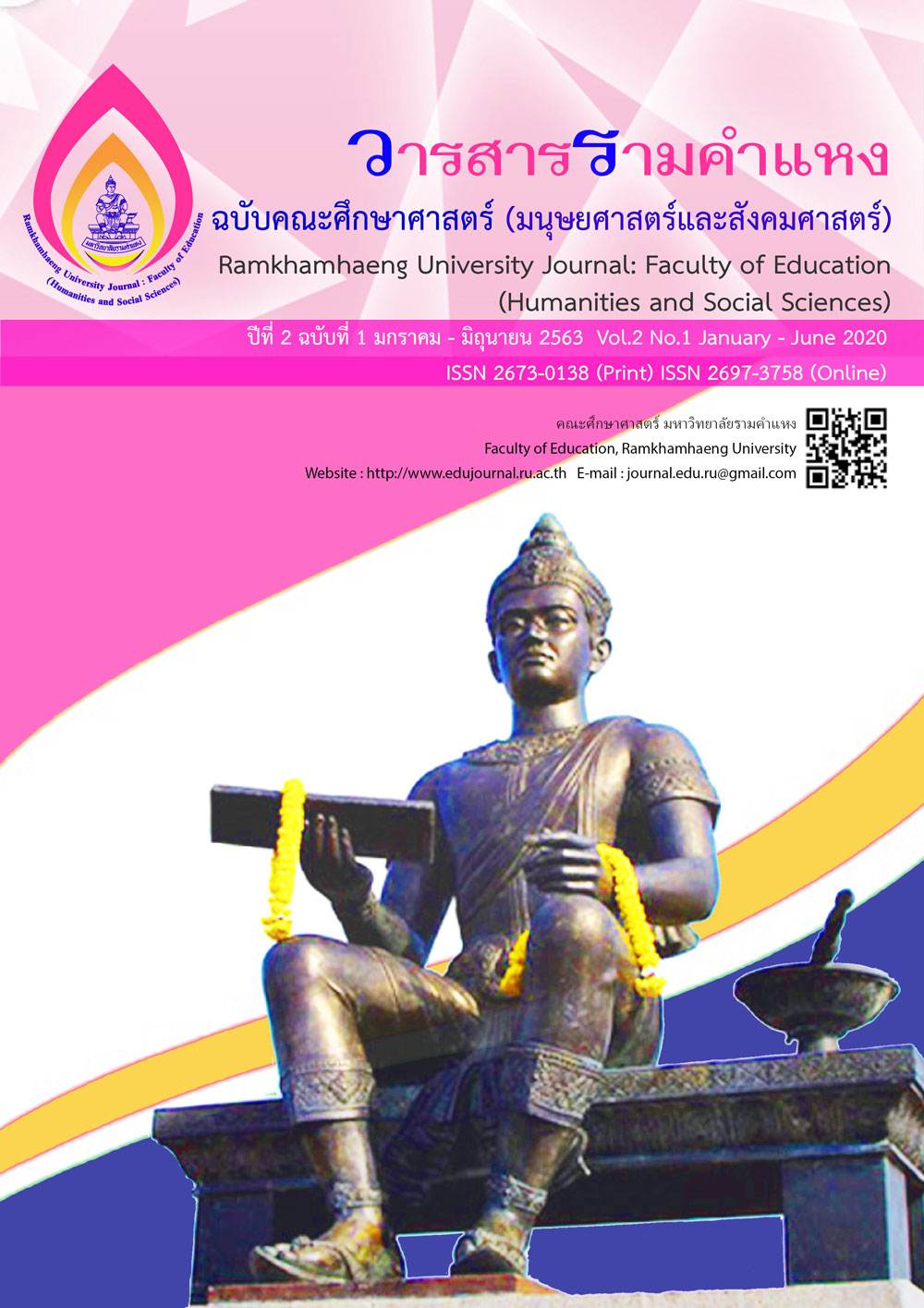Factors Related to Sexual Risk Behavior of Students at the Demonstration School, Ramkhamhaeng University, Bangkok
Main Article Content
Abstract
This research aimed to (1) study personal factors, predisposing factors, enabling factors, reinforcing factors and risk behaviors in sexual relations of students at Ramkhamhaeng University Demonstration School, Bangkok, and (2) to study the relationships between personal factors, predisposing factors, enabling factors, reinforcing factors and risk behaviors in sexual relations of students at Ramkhamhaeng University Demonstration School. The sample used in this research was 185 students in grade 9 from the Demonstration School, Ramkhamhaeng University. The study instrument was a questionnaire included 5 sections with contents of 1) personal data, 2) predisposing factors (knowledge, attitude to risk behaviors in sexual relations), 3) enabling factors (access to sexual stimulation media), 4) reinforcing factors (family sexual communication, parental control and supervision), and 5) risk behaviors in sexual relations. The reliability of the questionnaire was 0.859. Data were collected during 11 to 18 February 2019 and data were analyzed using descriptive statistics such as, percent, mean and standard deviation. Correlations were analysed by using Chi-square test and Pearson’s product moment correlation coefficient with sigfinicant level at p = 0.05. The results of this research revealed that most sample was male, (55.10%), having academic grades between 3.00 - 4.00 , (56.80%). Most students lived with their parents (74.50%), and received parents’ money about 100-200 Baht per day (80.50%). Knowledge, attitude towards risk behaviors for sexual relations (predisposing factors), and access to sexual stimulation media (enabling factors), were at a low level with 50.80%, 43.80%, and 51.40%, respectively. Family sexual communication was reported as high level, 39.50%. While the parental control and supervision and sexual risk behavior showed at the moderate level, with 44.30%, and 76.90%, respectively. Sex was associated with sexual risk behavior with statistical significance at the level of 0.05. Expenses received from parents and knowledge did not correlate with risk behavior for sexual relations (p> 0.05). Attitude towards risk behaviors for sexual relations and parental control and supervission were positively correlated with risk behavior for sexual relations (r = 0.146, r = 0.184, respectively) at the statistical significance level of 0.05. Media access to stimulate sexual emotions of students and family sexual communication were positively correlated with risk behaviors for sexual relations (r = 0.325, r = 0.206, respectively) at the statistical significance level of 0.05. The results of the research have suggestion that because the majority of the students had knowledge and attitude towards risk behaviors for sexual relations at low level, therefore, there should be education and teaching about sex education, including problems of premature sexual intercourse. The results of this research including those involved should be used in the planning and development of efficient activities for prevention of risk behaviors for sexual relations.
Downloads
Article Details

This work is licensed under a Creative Commons Attribution-NonCommercial-NoDerivatives 4.0 International License.
ผู้ส่งบทความ (และคณะผู้วิจัยทุกคน) ตระหนักและปฎิบัติตามจริยธรรมการวิจัยอย่างเคร่งครัด ทั้งนี้บทความ เนื้อหา ข้อมูล ข้อความ ภาพ ตาราง แผนภาพ แผนผัง หรือข้อคิดเห็นใดๆ ที่ปรากฎในบทความ เป็นความคิดเห็นและความรับผิดชอบของผู้ส่งบทความ กองบรรณาธิการไม่จำเป็นต้องเห็นตามเสมอไป และไม่มีส่วนรับผิดชอบใดๆ โดยถือเป็นความรับผิดของของเจ้าของบทความเพียงผู้เดียว
References
Green, L. W., & Krueter, M. W., (2005). Health promoting planning: An education and ecological approach (4thed.). New York: McGraw-Hill.
Kaewriengdach, C, & Hirunwatthanakul, P. (2016). Factors associated with sexual risk behaviors among secondary school students in Nakhon Phanom Province. Journal of the Royal Thai Army Nurses, 17(3), 168-177.
Kanokthon, T. (2010). Private universities’digital media perception of senior high school students in Eastern region. Master’s Thesis in Business Administration, Srinakharinwirot University.
Muangkrabi School. (2012) . Problems which lead to sexual intercourse. Retrieved January 3, 2019, from: https://boykub193.wixsite.com/sexual-relations/blank-xwgq
Paowattana, A., & Ramasuta, P. (2008). The difference of the factors predict sexual behaviors of adolescent women who have ever and never sexual intercourse in slum areas in Bangkok. Journal of the Medical Association of Thailand, 91(4), 542-550.
Sangaroon B. (2014). Factors affecting sexual risk behaviour among adolescent with early intercourse in secondary school under the jurisdiction of the office of basic education commision Bangkok. Master’s Thesis in Home Economics, Rajamangala University of Technology Phar Nakhon.
Sriwringya J. (2015) . Factors related to sexual risk behavior of mattayomsuksa 2 students the secondary educational service area office 2 Bangkok, Samut Prakan. Master’s Thesis in Nursing Science, Huachiew Chelermprakiet Univesity.
Vorapongsathorn, T., & Vorapongsathorn, S. (2018). Sample size calculation for research using G*Power program. Journal of Health Promotion and Environmental Health, 41(2), 11-21.
Vorapongsathorn, S. (2015). Research in education (3rd Ed.). Bangkok: Vitoon Karnpok Printing.

